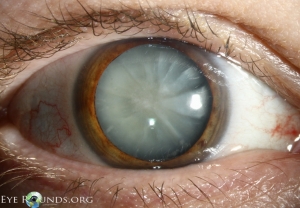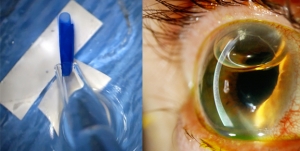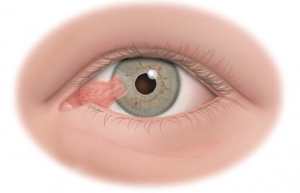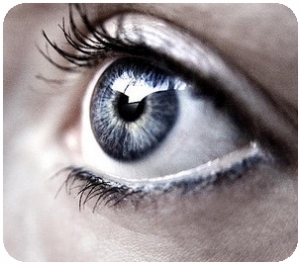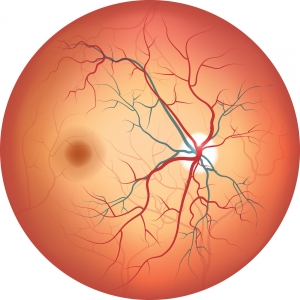Visian ICL
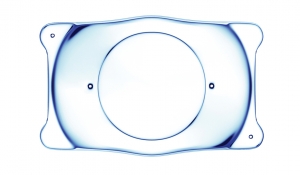
At Riverwoods Eye Center, we pride ourselves in having the capability to offer our patients a complete selection of vision correction procedures that can be customized to their unique needs and provide the best possible outcomes. That’s why we’re excited to offer the Visian ® ICL™ (implantable Collamer® lens) at our center. To date, more than 500,000 Visian ICLs have been implanted in patients worldwide. The Visian ICL is a lens made of Collamer implanted in the eye to correct moderate to severe nearsightedness and may provide improved vision quality compared to LASIK in these patients. In fact, more than 98% of military personnel that have opted for the Visian ICL are seeing 20/20 or better.
The Visian ICL (Implantable Collamer Lens) is made of an advanced soft-material lens, composed of 100% biocompatible collagen copolymer, that provides not only UV protection and permanent vision correction, but also a quality of vision that is sharp, clear, and vivid. Additionally, the Visian ICL is removable if necessary and the procedure does not permanently alter the shape of your cornea.
What is Visian ICL?
The Visian ICL (Implantable Collamer Lens) is made of an advanced soft-material lens, composed of 100% biocompatible collagen copolymer, that provides not only UV protection and permanent vision correction, but also a quality of vision that is sharp, clear, and vivid. Additionally, the Visian ICL procedure does not permanently alter the shape of your cornea. There is no maintenance associated with the lens, and it is intended to remain in place as long as you are satisfied with your vision. If at any point your vision changes or you wish to have them removed, it can be done easily and because your cornea is in its natural state, you are able to pursue other vision correction options.
What are the advantages of the Visian ICL?
If you are between the ages of 21 and 45, and suffer from a moderate to severe degree of nearsightedness, then you may be a candidate for this great procedure and the advantages it provides. These include:
- Immediate vision improvement at all distances – eliminating the need for glasses or contacts
- Sharp, Clear Vision: You can enjoy a new level of vision correction that’s sharp, clear, vivid, and has great depth and dimension.
- Designed to be Permanent, Yet Is Removable: One of the compelling advantages of the Visian ICL is that while it can permanently correct your vision, the lens can be simply removed and/or replaced if necessary. Also, concerns involving the cornea typically do not apply to the Visian ICL, as no natural corneal tissue is permanently removed or reshaped in during implantation.
- Does Not Cause Dry Eye Syndrome: Visian ICL does not cause or contribute to dry eyes. If you have dry eyes, ask your doctor if the Visian ICL may be the best vision correction option for you.
- Short Recovery Time: The recovery for the Visian ICL is quick and pain-free, and may be as little as one day due to the very small size of the opening required. Patients typically experience minimal discomfort, and many times go back to work the next day.
- UV Protection: Long-term exposure to UV radiation can damage your eyes; and longer term or more intense exposure increases the chance of eye disorders including the development of cataracts and some retinal problems. As an added feature, the Visian ICL advanced lens material contains a UV blocker that actually prevents harmful UVA and UVB rays from entering the eye, possibly preventing the development of UV related eye disorders.
- Treatment Flexibility for the Future: Your vision changes as you grow older and eventually almost everyone will need cataract surgery. An important benefit with the Visian ICL is that you have options for future treatments. Because Visian ICL maintains the structure of the eye, the measurements required for new procedures are often much easier to identify and can increase the likelihood of positive outcomes.
- Simplification of Life: There is no daily maintenance as with traditional contact lenses, and no concern of problems from daily activities such as swimming and sports.
- LASIK Alternative – Patients who have corneas too thin or prescriptions too high for LASIK can still have a fantastic option for lasting vision correction.
How is the procedure performed?
The Visian ICL procedure is an outpatient procedure that generally takes around 15 minutes. Prior to the procedure you will receive topical anesthesia drops to minimize discomfort. Then the doctor creates a very small opening to insert the lens into the eye with an injector. Once the lens is injected, it unfolds in the eye and the procedure is complete. Patients usually experience an immediate improvement in vision and are “wowed” by the results.
The Visian ICL procedure is an outpatient procedure that generally takes around 15 minutes.
Who is a candidate for Visian ICL?
If you are between the ages of 21 and 45 and nearsighted, you may be an excellent candidate for the Visian ICL. This procedure is able to treat a range of patients from low to extremely high refractive errors and is especially beneficially to those with thin corneas and dry eyes. It is preferable that the patient has not undergone any ophthalmic surgery and does not have a history of eye disease such as iritis, glaucoma, or diabetic retinopathy.
If you are between the ages of 21 and 45 and nearsighted, you may be an excellent candidate for the Visian ICL.
Who is NOT a candidate for Visian ICL?
At , we always recommend you undergo a vision consultation to determine the best vision correction plan for you. If the Visian ICL is not right for you, other options are available. Vision ICL may not be the best course of action for:
- Patients whose eye prescription has changed in the last six months
- Patients without a large enough anterior cell density
- Patients with an anterior chamber depth of less than 3.00mm
- Patients who are pregnant or nursing
- Patients with uncontrolled dry eye or blepharitis
- Patients with corneal endothelial dystrophy
The Visian ICL received FDA approval to treat a wide range of myopia in 2005.
Is the Visian ICL FDA approved?
Yes. The Visian ICL received approval from the FDA for a wide range of myopic (nearsightedness) correction needs.
What is the track record of the Visian ICL?
Extensive research and development preceded the introduction of the Visian ICL. It is now being used by more than 500,000 patients worldwide. The satisfaction rate among patients is extremely high – above 99%. The Visian ICL provides unparalleled quality of vision and has excellent and stable outcomes for patients with moderate to severe myopia. The Visian ICL has been available internationally for over 10 years.
Can the Visian ICL be removed from my eye?
Although the lens is intended to remain in place permanently, a surgeon can remove the implant if necessary.
Is the Visian ICL visible to others?
No. The Visian ICL is positioned behind the iris (the colored part of the eye), where it is invisible to both you and observers.
The Visian ICL implant is invisible both to you and observers.
Will I be able to feel the Visian ICL once it is in place?
The Visian ICL is designed to be completely unobtrusive after it is put in place. It stays in position by itself and does not interact with any of the eye’s structures.
Next Steps
Feel free to contact us at Riverwoods Eye Center with any questions that you may have, or to schedule an eye exam to discover if the Visian ICL or an alternative vision correction procedure is right for you.
LASIK is the most popular laser eye surgery to treat nearsightedness, farsightedness and astigmatism. In most cases, LASIK takes about 15 minutes for both eyes with minimal discomfort after the procedure. It requires only a topical anesthetic and no bandages or stitches are needed. The LASIK procedure works by reshaping the cornea to enable the light entering the eye to focus properly onto the retina. Numbing eye drops are applied to the eye surface and Dr. Ward creates a thin circular flap in the cornea using the highly precise Intralase femtosecond laser. iLASIK is blade-free and much safer than regular LASIK, where a blade is used to make the flap. The hinged flap is then folded back to access the underlying cornea. Using a second, highly specialized exicmer laser, Dr. Ward removes a small amount of tissue to reshape the cornea and “build in” your prescription. The flap is folded back down and serves as a natural bandage. LASIK is performed on each eye separately, with each procedure taking only about five minutes. Most patients experience little or no discomfort after LASIK. In as short as 24-hours, patients can enjoy vision of 20/20 or better without glasses or contacts.
PRK only takes about 10 minutes to complete and people typically enjoy 20/20 vision after surgery, but it can take longer to achieve this level of vision compared to LASIK and Visian ICL surgery. PRK was developed before LASIK as the original method of laser vision correction for nearsightedness, farsightedness and astigmatism. It has also been called “advanced surface ablation” and “LASEK.” The idea behind PRK is the same as LASIK–using a highly specialized excimer laser to reshape the cornea and “build in” your prescription. PRK differs from LASIK in how the surgeon reaches the cornea before performing the laser ablation. During a LASIK procedure, the surgeon cuts a thin, hinged flap on the outer surface. With PRK, instead of cutting a flap, the surface layer of the cornea is removed, giving the surgeon access to the entire thickness of the underlying cornea. The surface layer naturally grows back in 2-3 days. So why choose PRK over LASIK? PRK is of particular benefit if the cornea is too thin for LASIK or if a patient has undergone LASIK previously. PRK also eliminates the risk of flap complications and reduces the chance that too much of the cornea will be removed. Dry eye is generally less of a problem after PRK compared to LASIK, so it is favored in patients with a tendency to have dry eyes. So why choose LASIK over PRK? The main downsides of PRK compared to LASIK and Visian ICL surgery are postoperative discomfort (lasting 2-3 days) and prolonged recovery of vision (usually 3-4 weeks).
Cataract and Lens Implant Surgery
Cataract is a clouding of the natural lens of the eye that causes blurry vision and often halos and glare. When the lens becomes cloudy or opaque, we rename it “cataract.” Most cataracts are age-related and worsen gradually over time. Diabetes and use of steroid medication can cause cataracts to progress more quickly.
At Riverwoods, we use the latest surgical techniques for cataract removal and offer a wide variety of lens implants including multifocal and astigmatism correcting lenses. We take extra time to ensure our patients understand what lens options are best suited to their particular situation and goals.
Standard lens implants are usually covered by insurance and provide excellent vision quality after cataract surgery. Patients often require glasses or contacts after surgery to obtain their best level of vision. Standard lenses do not correct astigmatism and do not provide distance and reading vision.
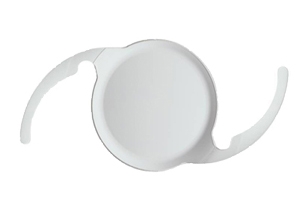 Multifocal lenses can correct presbyopia and provide excellent distance and reading vision, reducing or eliminating dependence on glasses of any kind.
Multifocal lenses can correct presbyopia and provide excellent distance and reading vision, reducing or eliminating dependence on glasses of any kind.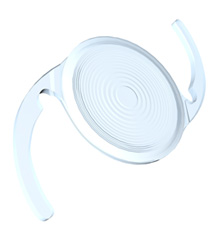 Astigmatism correcting lenses (known as “toric” lenses) can reduce or eliminate the need for glasses at distance, though reading glasses are often still required for near work.
Astigmatism correcting lenses (known as “toric” lenses) can reduce or eliminate the need for glasses at distance, though reading glasses are often still required for near work.

Riverwoods Eye Center also provides advanced surgical services for patients requiring complex cataract surgery, sutured lens implants, or iris reconstruction.
Advanced Cornea Care
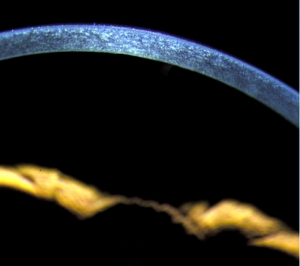
At Riverwoods Eye Center, Dr. Ward has additional fellowship training in corneal diseases and offers full-service cornea care using the most advanced diagnostic and surgical techniques available. Our state-of-the-art imaging suite includes corneal topography, anterior segment OCT, and confocal microscopy to aid in the accurate and timely diagnosis of disorders such as Fuch’s endothelial dystrophy, keratoconus, bullous keratopathy, map-dot-fingerprint dystrophy, recurrent erosion syndrome, dry eye syndrome, Salzmann’s nodular degeneration, post-LASIK ectasia, squamous tumors, and corneal infections.
Dr. Ward utilizes the most modern techniques in performing cornea transplants including DALK (deep anterior lamellar keratoplasty) for keratoconus and penetrating keratoplasty. He has a special interest in the management of Fuch’s dystrophy and was the first in Utah to offer the most advanced form of cornea transplant for this condition (see DMEK cornea transplant tab). We are now excited to offer FDA-approved corneal collagen cross-linking (KXL) for treatment of keratoconus and post-LASIK ectasia.
DMEK Cornea Transplant
Pterygium Surgery
Pterygium (tur-ij-ee-um) is a growth on the surface of the eye that attaches to the cornea (clear window of the eye). It is caused by many years of sun exposure and can result in irritation, redness, and blurry vision. If the irritation cannot be relieved by eye drops or if the growth is getting close to the pupil, then surgical removal is recommended. At Riverwoods Eye Center, we provide state-of-the-art no-stitch surgery using specialized tissue glue and a graft to repair the defect left by the pterygium removal. This method maximizes post-operative comfort and reduces the chance of the pterygium growing back.
Complete Eye Exams
We use modern equipment and technology to help achieve the most accurate prescriptions and comfortable contact lenses. At our office, the doctor personally performs the refraction and verifies the prescription.
Glaucoma and Diabetes Care
Diabetes and glaucoma can cause gradual changes in the eye before they result in noticeable vision problems. We provide regular preventative exams to catch any problems early so that vision is preserved. We utilize a wide array of technology to diagnose and monitor these conditions and provide treatment when necessary. The vast majority of vision loss from these conditions can be avoided with proper treatment and follow up.
